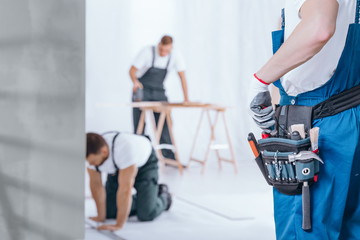Handyman Naperville IL can make a good living by offering various services to homeowners. It’s important to focus on the right clients. If a client is interviewing multiple handypersons, badmouthing their previous contractor, or giving vague instructions, steer clear of them and find another customer. It’s also important to have the right tools. Check out this list of the best handyman tools to help you get started.
 The fish tape is a wire that handymen can use to pull cables through walls, floors and conduit. This is an excellent tool to use when there are existing electrical circuits in a home, office or other building that need to be run elsewhere. It can also be used to add new lighting fixtures, appliances or other electrical equipment. A specialized tool with a plastic-coated steel wire, it is durable and can be bent without breaking. It is available in different lengths and thicknesses.
The fish tape is a wire that handymen can use to pull cables through walls, floors and conduit. This is an excellent tool to use when there are existing electrical circuits in a home, office or other building that need to be run elsewhere. It can also be used to add new lighting fixtures, appliances or other electrical equipment. A specialized tool with a plastic-coated steel wire, it is durable and can be bent without breaking. It is available in different lengths and thicknesses.
Most fish tapes are stored coiled on a reel that allows the user to quickly access the right length of tape for each job. They have a slight curve that helps guide them into tight spaces. A handyman may want to consider non-conductive fiberglass fish tapes as they do not conduct electricity and can help reduce the risk of shock when working around energized circuits.
It is important to turn off the power to any electric circuits before using fish tape in a residential or commercial space. This will prevent the possibility of accidental contact with live wires. A handyman should also consider the use of an insulated fish tape that has been tested to be non-conductive and resists voltages up to 1000V.
Typically, these fish tapes will have supports ties wrapped around them to hold them in a coiled shape while they are not being used. When they are ready to be used, the support ties must be removed before pulling on the tape. Some types of fish tape have a button that must be pushed before the tape can be pulled out, while others simply require the user to grab onto it and pull it out.
Electrical Tape
Electrical tape is a general purpose insulating tape with a pressure-sensitive adhesive. It’s used to wrap and insulate electrical wires, as well as other material that conducts electricity. It’s usually made of vinyl or PVC and comes in a variety of colors for color-coding wire applications. In addition, electrical tape can withstand moisture and humidity.
It’s important to note that before using any electrical tape, the handyman must ensure that the area’s power is completely off. This is to prevent potential electric shock from the taping process. It’s also a good idea to use a voltage tester to check for current in the area.
When it comes to buying electrical tape, the first thing that a handyman should consider is its stretch and elongation capabilities. This is because electrical tape needs to be stretched and tightly wound around a wire in order to effectively adhere. A low-quality tape may not be able to elongate as much before breaking, which can make it difficult to use.
The next step is to look for an electrical tape that carries Underwriters Laboratories (UL) approval. This is to ensure that it has been tested based on national safety standards. Finally, a handyman should choose an electrical tape that is thicker than the wire’s insulation in order to provide adequate protection. Otherwise, it could fail to adequately prevent the flow of electricity, which can result in a fire. Moreover, it is crucial to remember that binding wires with electrical tape should only be done as a temporary solution. Permanent connections should be made with wire nuts, which will offer a better and more durable solution. Nonetheless, electrical tape can be useful for making minor repairs to cables or ensuring that they are properly insulated.
Circular Saw
A circular saw is a powerful tool for any handyman. It can be intimidating to use, but with proper training and practice, it can provide great results for any project. Like any power tool, a circular saw is dangerous if not used properly. A handyman should always follow safety precautions when using this tool to avoid injury.
First, make sure the saw is fully unplugged or unattached from its battery and that it is not positioned on top of any material that could fall and be cut by the blade. Then, set up a straight edge guide to rest the side of the saw plate against. This will help you get a straight cut and prevent the blade from binding or causing kickback.
Then, attach the appropriate blade for your project. A standard wood cutting blade is fine for most projects, but you may need to switch to a metal-cutting or plastic-cutting blade for certain materials. Finally, plug in the cord or connect the battery and turn on the saw. The trigger is usually on the right side of the handle, and a thumb-activated safety switch keeps the blade from accidentally starting.
Most circular saws have notches on the base plate that line up with the cutting edge of the blade for 0° and 45° bevel cuts. This feature is helpful, but every blade is slightly different and a straightedge can be much more useful for achieving a perfectly straight cut. Once the cut is completed, wait for the blade to stop before lifting it from the material. Be sure to wear eye protection, ear protection and a dust mask to protect yourself from the loud noise and flying debris caused by the blade.
Hammer
A hammer is a hand tool consisting of a weighted head fixed to a long handle that can be swung to deliver an impact to an object. Hammers can be used to drive nails into wood, shape metal (as with a forge), or break things into pieces. They come in a variety of shapes, sizes and weights ranging from ounces to pounds. Most hammers are made of steel, but some have titanium heads.
Handymans use hammers for many different tasks, including installing home fixtures and appliances. They also use them to repair damaged walls and other structures. When choosing a hammer, it is important to choose one that is lightweight and well-balanced. A heavy hammer can cause wrist fatigue and may result in wild swings that could damage the item being hit.
Using a hammer effectively can be difficult for beginners, but there are some tips that can help them improve their technique. The first tip is to grip the hammer with the thumb and forefinger of the nondominant hand. This will prevent your fingers from getting crushed if the hammer misses its target. It is also important to use a smooth, controlled swing. Doing this will ensure that the hammer hits its target rather than the wood or other structure.
Another helpful tip is to place a stop loss below the low of the hammer pattern. This will protect the trade from a possible reemergence of downward pressure and allow for a quick exit if necessary. The level at which the stop is placed will depend on the trader’s confidence in the hammer signal and their risk tolerance. It is important to note that the hammer pattern does not provide a price target, so the trader will need to decide on an optimal exit level based on other types of candlestick analysis or other technical indicators.
Pliers
Pliers are a tool that every handyman should have in their arsenal to help them grip, position, tighten or loosen objects. They can also cut, which makes them ideal for a variety of home and workshop tasks. A good quality pair of pliers should have multiple jaw configurations for different uses and have several other features such as high leverage, locking and insulated handles.
The jaws (the part of the pliers that grip the object) come in various shapes and sizes and have different types of teeth and serrations to increase their gripping power. They may also be angled, tapered or have multiple sections of different shapes. Some pliers have a rounded head, which is useful for pulling nails or similar items. The handles (which the user squeezes) are covered with a variety of materials to provide comfort, with some models having insulated handles to protect against electric shocks.
Most pliers have a pivot point, which is where the two parts of the jaws meet. The closer the pivot point is to the jaws, the more gripping power and cutting capacity the pliers have. Some pliers have additional functions or features, such as a cutter, which can be used to cut wire of various thicknesses.
Other specialised pliers include slip joint, channel and locking varieties. For example, slip joint pliers have a sliding mechanism rather than a pivot point, which increases the distance between the jaws and allows them to grip wider objects. Channel pliers are great for cutting through pipes and other narrowly-sized items, while locking pliers can clamp down with a lot of force but should not be used on reusable fasteners as they could damage them.

